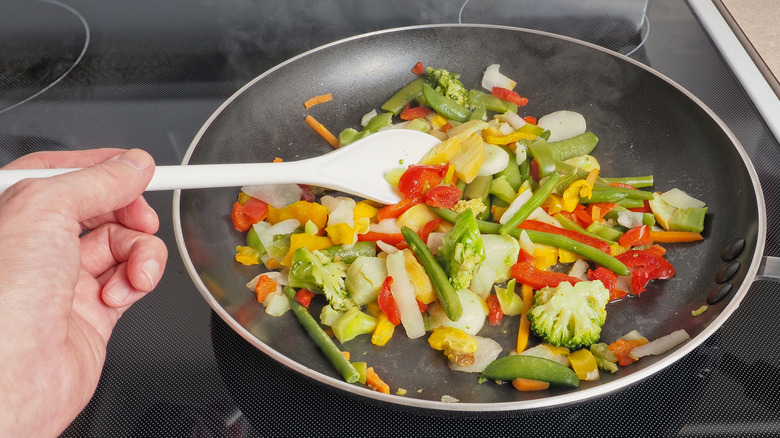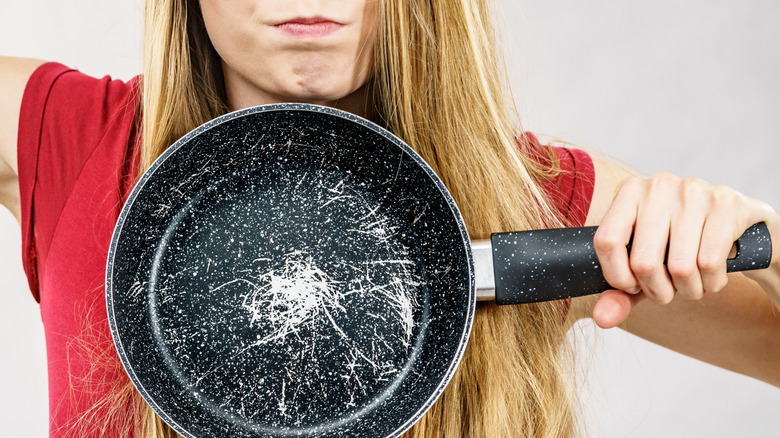How Your Cooking Utensil Is Making Food Stick All Over The Pan
You may have found that for a product deemed "nonstick," your nonstick pans seem to be pretty good at clinging to food. While this could be for several reasons, including high heat, quality of the pans, and type of food, there's often one specific culprit, and that's your utensils. Nonstick pans are very different from other cookware, and thus they need to be treated differently. Use the wrong utensil while cooking in one of these pans, and your food is likely to stick not just this time, but forever.
Specifically, metal cooking utensils are absolute murder on nonstick surfaces. It's pretty much the cardinal rule that you should never use a metal fork, spoon, or spatula on nonstick pots and pans because they create scratches. Once a nonstick coating gets scratched up, it's ruined and will no longer repel sticky foods. What's more, that small scratches are easy to make, and they tend to get worse over time. Therefore, even using a metal whisk in a nonstick frying pan even once could easily be its death kiss.
How nonstick pans work
There are a number of other reasons why food might find a way to stick to nonstick pans, but it still all has to do with how these pans are made. To get that nice smooth surface, many older pans have a coating of PFAs — or polyfluorinated compounds. Nowadays, they have a very similar polytetrafluoroethylene-based coating instead. These chemicals repel water and stains, so food slides right off. However, they only work well when their surface is completely unbroken. For any of these pots or pans, you should only use wooden, nylon, or silicone utensils to preserve the coating.
This coating is also only meant for low heat and gentle cooking, so vigorous scraping, use on an open flame, or placement in the oven can permanently damage the surface. That surface, though useful, is very susceptible to scratches, and even if you're very gentle-handed, using metal utensils during cooking can mess up the coating. To get the most out of your nonstick cookware, you should handwash it with gentle soap and water, store it without stacking, and use it for only temperatures below 500 degrees. You should also never heat it up dry without oils or liquids in it; that will help preserve the finish from degradation.
So how do you fix the scratches?
The short answer is that you don't. Once a nonstick pan gets scratched or starts flaking, it's time to throw it out and get something new. Sticking with an old nonstick can actually be hazardous to your long-term health. A 2022 study by Science of the Total Environment found that after being even slightly scratched, Teflon pans with "forever chemical" coatings can release thousands, if not millions, of plastic nanoparticles. These particles have been linked to serious health problems, including cancer. So, if you spot a scuff on one of your nonstick pots or pans, its days are probably numbered.
Luckily, there are plenty of alternative cookware options. Ceramic cookware is less likely to scratch than PFA surfaces, but you should still be careful with metal utensils when using it. Stainless steel does not have any PFAs and thus no nanoplastics, and can be heated on stovetops as well as in ovens. Once properly seasoned, cast iron skillets can provide a nonstick surface that can stand up to metal utensils. Using plenty of fats, oils, and cooking spray before the food goes in can also make any steel, ceramic, or iron pan easier to cook in. If you want to hang onto your nonstick pans, just remember to keep metals far away from them, no matter what.


